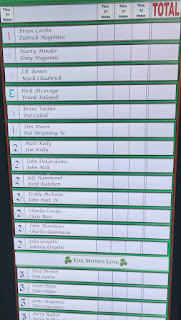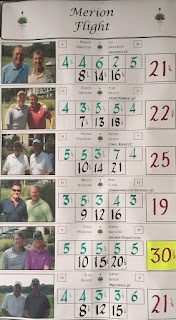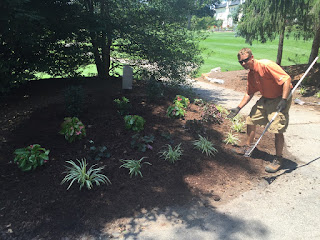Thursday, December 15, 2016
Saturday, November 26, 2016
Saturday, November 12, 2016
Monday, November 7, 2016
Final phase of double row irrigation.
Friday, October 28, 2016
Damage caused by a golf cart after 10:45 on Friday Oct.28th.
Wednesday, October 5, 2016
Doug Miller celebrates 25 years on WVCC's grounds staff.
Sunday, October 2, 2016
Thursday, September 15, 2016
Pool area gets fresh sod.
After a couple of aerations, some fertilizer and a hand rake the pool lawn gets fresh sod. The sod we placed in the spring was behind the 8 ball from the start. We were in such a hurry to get everything finished, proper preparation of the area was not able to be accomplished. The new sod will enhance the area right away and now has months to root in and establish.
Wednesday, September 14, 2016
NASA close up picture of Mars ? No, this is a picture of the soil at the pool after sod removal.
Friday, September 2, 2016
PLEASE ! When practicing putting, move around a bit to reduce damage to putting green!
This Picture was taken on August 12th, 2016 on the putting green at Whitemarsh Valley CC.
The damage was created by practicing the same putt over and over......and over while shifting their feet.
This picture was taken of the same spot on September 2nd, 2016. Notice the lingering damage. This could take another month to heal.
So remember to change areas of putting often to prevent this type of damage.
Wednesday, August 31, 2016
New irrigation at #11 installed and throwing water.
Tuesday, August 30, 2016
Irrigation improvements started today for hole #11.
We will be adding (6) sprinkler heads to the right of the 11th fairway. They will be placed in the rough right of the right side bunkers. This additional coverage will provide better watering results for the 11th fairway.
Thursday, August 18, 2016
Wednesday, August 17, 2016
Summer information from Turfgrass Disease solutions, LLC
Relentless July and August Leads to Major Turfgrass
Problems
16 August 2016
Turfgrass Disease Solutions, LLC
Over the past three
weeks, I have visited more than 65 golf courses in Delaware, Maryland, New
Jersey, New York and Pennsylvania and there is one common theme,
stressed turf due to the relentless weather since mid to late July. The recent
high day time temperatures, warm nights, humidity, intense sunlight, wind and
then spotty thunder storms have placed incredible stress to all cool season fine
turfgrass areas. The weather has not discriminated amongst private nor public
clubs, high budget or low budget courses - every golf course is showing signs
of stress in some regard. It has been a brutal season to try to maintain green
speeds, manage moisture and playing conditions. Due to the varying climates,
budgets, ages, and designs throughout the region, golf courses should not be
compared to one another. The growing season of 2016 is bringing chronic issues
such as air movement, drainage, shade and weak species to the fore front.
The most common problem
I have encountered, especially in regions that are receiving rainfall, is
severe wet wilt to fairways, tees and greens. Wet wilt is a physical problem in
which the soils are saturated and the grass cannot transpire water to cool
itself because of poor air movement and high humidity levels. This has been
most commonly observed in low lying areas of fairways, tees and greens. Most
commonly, it is complete decline or the only live grass is in aeration holes
from this spring or last fall. Wet wilt is very difficult to manage and can
take up to 10 days to fully show up, especially on higher cut tees and
fairways. Typically, you will see that golf cart tire tracks wilt quickly and
then decline even when the soil moisture is adequate. If you are experiencing
wet wilt, be conservative with mowing heights and use solid front rollers.
Rolling greens is a significant stress to thin turf. On fairways, in the short
term, limit cart traffic and restrict to roughs or paths. Don’t be afraid to
preventively syringe turf that is showing signs of wilt with adequate soil
moisture. Long term, explore options to improve drainage and air movement.
Dry wilt is also a
problem for many golf courses not receiving rainfall in some regions. This
places an incredible load on the staff to manage moisture with hoses and
overhead irrigation, which is tough in the heat. If you are in a dry period, be
sure to check that irrigation heads are properly functioning. Far too often an irrigation
problem shows up when the stress shows up and with the heat we have
experienced, it’s a slow road to recovery. Beyond lack of water or too much
water, is decline in the poorest growing environments. Air movement is the most
important growing environment consideration during warm, humid periods. Air
movement is needed for fine turf to be able to cool itself following light
applications of water (i.e. syringing). If there is no air movement, the turf
in that environment can be 8-12ᵒF warmer than turf receiving air movement naturally or
through fans. Fans have completely changed greens management in areas where
trees and underbrush cannot be removed. Air movement is the key for syringing
to work. If the turf does not dry in between syringing, the effects are minimal
and the turf will begin to thin.
Mechanical stress is
showing up throughout the region, especially in shaded areas. Mechanical
stress, although self-inflicted, is tough because superintendents are trying to
produce a playable golf course. The two most common mechanical issues I see are
roller damage to the collars or mower stress from turning or to the edges
(clean ups) of greens. Be sure to watch staff turn mowers and use rollers to be
sure they are properly completing the task and adjust heights if mowing is
skipped. Skipping mowing may be needed during droughty or wet conditions but if
skipping mowing, be sure to assess the height of cut and not remove too much
tissue in a single mow. You will be able to work the height back down in time,
but the initial scalp can cause issues under the current environment.
Disease pressure has
been extremely high and every major turfgrass disease has been observed. Brown
patch and Pythium pressure has been high for the past three weeks. For those of
you maintaining perennial ryegrass, I have confirmed gray leaf spot over the
past week- this disease can be incredibly damaging under stress. In some of our
trials, we are seeing tighter spray intervals and high rates work best but
nothing will provide 100% control in extreme conditions or saturated, humid
conditions. Preventive fungicides should be applied as needed. If curative
control is attempted, be sure to have the disease properly identified and use
the best course of action. Annual bluegrass weevils have been significantly
damaging bentgrass fairways and tees for the past 3 weeks. We have found early
instar white grubs in some of the untreated plots in our research trials so be
sure to scout for them if you are seeing wilt or unthrifty turf. Be sure to
scout for insect pest and treat accordingly.
In a quick outline,
these are just a few of the major observations I have had in my recent visits.
Other common themes include: elevated amounts of phytotoxicity
(injury from commonly used plantprotection agents), elevated plant parasitic nematode levels, physical injury from aggressive golf shoes
and damage from venting or spiking greens and/or sand topdressing on weak and/or stressed turf. For
those of you considering aerification in the near future, please assess the health of the turf before aeration
or use a less aggressive technique. Aeration should not be looked upon as a tool to renovate weak turf,
but rather a tool to promote long term health. Aerification of weak turf in August can lead to weak turf in
September and October which are two of the most important golf months in the Mid-Atlantic region.
Feel free to reach out with a phone call/text (610.633.1878) or
email
(turfgrassdiseasesolutions@yahoo.com).
Steve
McDonald
Monday, August 15, 2016
Due to grees aeration golf course will be closed today.
With the hot weather we have experienced over the last week, aeration procedure will be limited today. We will still be aerating greens but will be conservative on how many we do. The entire golf course will be closed all day today.
Monday, August 8, 2016
Summertime Bermudagrass suppression in action.
Bermudagrass:
Where did it come from and why do we still have it?
In the 1950's Whitemarsh Valley CC brought in common Bermuda-grass to ensure green fairways in the summer. The irrigation systems of the day were inadequate to supply the proper coverage for the existing grass. For the next 30 years the club enjoyed dense fairways in the summer and fall but put up with the thin lies in the spring.
The club decided to change over to Bentgrass in 1994 after a brutal winter killed all the Ryegrass and Poa annua on the fairways. The plan was to spray roundup (non-selective herbicide) to remove all Bermuda, Ryegrass and Poa annua from the fairways only while keeping the rough playable during the grow in of the Bentgrass. This plan succeeded in the fairways but over the years the un-effected Bermuda-grass in the roughs tillered their way into fairways. At this time there are not any products that can outright kill Bermuda-grass and not harm Bentgrass. In 2012 a product came out that actually suppresses Bermuda-grass while being relatively harmless to Bentgrass. This is where we are at today, constant suppression during the summer months and reduced Bermuda-grass the following year.
The club decided to change over to Bentgrass in 1994 after a brutal winter killed all the Ryegrass and Poa annua on the fairways. The plan was to spray roundup (non-selective herbicide) to remove all Bermuda, Ryegrass and Poa annua from the fairways only while keeping the rough playable during the grow in of the Bentgrass. This plan succeeded in the fairways but over the years the un-effected Bermuda-grass in the roughs tillered their way into fairways. At this time there are not any products that can outright kill Bermuda-grass and not harm Bentgrass. In 2012 a product came out that actually suppresses Bermuda-grass while being relatively harmless to Bentgrass. This is where we are at today, constant suppression during the summer months and reduced Bermuda-grass the following year.
This is a view of the 10th fairway after treatment of the Bermuda-grass suppression product. It causes the tips of the effected grass to turn white which sticks out compared the green color of the fairway.
This is a closer look at common Bermuda-grass while in the suppressed state.
This is a real up close look at what is going on. Over the past 4 years we have made real head-way in reducing the total Bermuda-grass population on the course, with further reduction expected in the future.
Saturday, August 6, 2016
Sunday, July 24, 2016
2016 Whitemarsh Valley CC Member guest champions! Chuck Lynch & Bill Jeremiah(Bidermann GC)
After 3 days of golf including (5) 9 hole matches and a very competitive practice round, the 2016 Whitemarsh Valley CC member guest concluded with a new champion team. Whitemarsh's Chuck Lynch and Bidermann GC member Bill Jeremiah won the shootout of flight winners to claim the top prize.
Congratulations to Chuck & Bill and to all the flight winners of this member guest tournament.
Tuesday, July 19, 2016
Wednesday, July 13, 2016
Sod installed on #5 foward tee surface.
Pictured is Senior Asst. Superintendent Jerry Stockmal watering the newly installed Bentgrass sod on #5 forward tee. The tee should be available for play in about two weeks or when it is deemed rooted in properly for play. This tee will be a major improvement over the one it replaced. Enjoy!
Tuesday, July 12, 2016
New tee surrounds being sodded.
Would you put down new sod when the forecast temperature will be well into the 90's ? Well, we did it anyway...... the timing of this new tee pointed to the week of July 4th and with the help of the majority of the staff we put down almost 5,000 square feet of a Fescue\Bluegrass mix sod. Water was applied both before and after the sod work. Now the only thing left is the Bentgrass sod for the tee surface.
Monday, July 11, 2016
GOLF COURSE CLOSED TO ALL PLAY TODAY .
The golf course will be very busy during the next two weeks, we will take full advantage of the golf course being closed today. With that said, the course is completely closed today to all play (even after 12:00)
With a new tee you will need new irrigation.
With the new tee replacing the old outdated one, the irrigation system has to be updated for the change in shape and location. The previous irrigation had only one sprinkler with less than stellar coverage. Pictured above are our two assistant superintendents Jerry Stockmal and Jim Dennison placing the new sprinklers and pipe into the ground.
Subscribe to:
Posts (Atom)


















































